Vector-transmitted diseases such as dengue fever, Japanese encephalitis, malaria, lymphatic filariasis and yellow fever are global burdens that affect tropical and sub-tropical regions, causing significantly high morbidity and mortality rates worldwide1,2. The Nepalese government has been continuously implementing a strong malaria control program, with the purpose of eliminating the local indigenous transmission of malaria3. Around 20.36 million people in Nepal (about 73% of the population) live in malaria-prone areas, which comprises 65 out of 75 districts. In particular, the 13 districts located in the Terai belt (the plain zone) bordering India are part of the high malaria endemic area, which includes the Kanchanpur and Kailali districts in the far-western area4.
The mosquito Culux tritaeniorhyncus, a main vector of the Japanese encephalitis virus, is prevalent in the rice paddies of the endemic areas during the transmission season in Nepal. From 1978 to 2004, the average fatality rate for Japanese encephalitis patients in Nepal was 20.2%, 60% of which were aged less than 15 years5. As Japanese encephalitis generally requires long-term medical treatment, it has a high economic impact on households with these patients6. In contrast, dengue fever, transmitted by Aedes mosquitoes, is accompanied by fatal clinical symptoms. In a cross-sectional study in the Terai belt of Nepal in 2007, the anti-dengue IgM-positive rate was about 30.0% out of 183 symptomatic people7. In Nepal, dengue fever occurred mainly in the central Terai region; however, it has substantially expanded into the western and far-western Terai region including Kanchanpur and Kailali districts8,9. Despite the increasing threat of dengue fever, to date Nepal has no effective dengue surveillance program.
Tikapur is a municipality in the Kailali district, one district outside of the far-western development region. Ecologically, it belongs to the Terai belt of Nepal, located in the southern part of Nepal. The Terai belt occupies 23.1% of the total land area and the population constitutes more than 48.4% of Nepal's total population. It contains the most fertile agricultural land and forests. The belt's ecosystem is very favorable to the breeding of mosquitoes that cause mosquito-borne diseases3. Among the 75 administrative districts of Nepal, the Kailali district has the highest number of disadvantaged ethnic groups, whose main source of income is agriculture. Due to their low socioeconomic status, people are bound to move to bordering countries such as India in search of work2. Furthermore, the area's unsanitary living conditions - including an unsystematic sewerage system, littered rubbish, and ditches of contaminated water - affect the increase in the number of mosquitoes10. Tikapur lies on the banks of the south-eastern Karnali River, where the temperature exceeds 37°C in the summer season and ranges from 7°C to 23°C in the winter season. Thus, Tikapur residents face the threat of mosquito bites throughout the year. Many aspects of the transmission cycle are strongly influenced by environmental conditions such as the climate, agricultural practices, land use, and urbanization, which are changing and might eventually allow the re-emergence of a setting that is more hospitable for mosquitoes11.
Although various control methods have been implemented to prevent the spread of mosquito-borne diseases, complete control and prevention remain a major challenge. Nowadays, people depend on commercial products such as bed nets, sprays, mosquito electric vaporizers and coils as protection from mosquito bites. However, these products are mainly utilized indoors and are not very effective for outdoor activities. Commercial topical mosquito repellents can elicit chemical side effects7,12,13. Perhaps for this reason, local people in Tikapur rarely purchase commercial chemical repellents despite their relatively low price and ready availability as an import from countries such as India. Plant-derived mosquito repellents such as citronella oil have been proven to have little or no adverse effects12,14. Citronella oil could be promoted as a mosquito repellent to be used in both indoor and outdoor activities due to its affordability, safety and accessibility in Nepal15,16.
This study was conducted to investigate the effectiveness and applicability of citronella oil as a natural mosquito repellent by measuring the mosquito repellency effect, irritation level, and smell satisfaction on human subjects in both indoor and outdoor conditions in the Tikapur Municipality of the Kailali district of Nepal.
Preparation of citronella oil
Citronella grass (Cymbopogon winteratus) harvested in Tikapur Municipality was processed using steam distillation equipment involving a boiler, a vessel, a condenser, and an oil separator. In this process, the water was allowed to boil at more than 100°C in a separate boiler, with a minimum pressure of 138 kPa and a maximum of 276 kPa. The steam was condensed and transferred to the vessel containing the citronella grass. The oil-bearing vapor was changed to a liquid through a cold-water condensor. Lastly, the water was separated from the oil.
Study design
The subjects of this study were recruited from among the people living in Tikapur Municipality. Age and sex were not restricted. To investigate the mosquito repellency effect of citronella oil, the number of people who were bitten and the number of mosquito bites were measured in indoor exposure (IE) and outdoor exposure (OE) tests.
For the IE test, 101 recruited volunteers were randomly divided into an experimental group (n=57), where 100% citronella oil was applied on both legs from the ankle to the knee, and a control group (n=44), where citronella oil was not applied. The two groups were exposed to mosquito bites on 9-12 April 2013 from 5.00 pm to 7.00 pm in two yoga training centers in Tikapur Municipality, far-western region of Nepal. In order to reproduce the general indoor conditions of houses in the area, the windows and doors of the experimental rooms were kept open 1 hour before the start of exposure testing and were not treated with any mosquitocides or mosquito repellent. To protect against mosquito bites, the bodies of the participants were covered with a mesh except for the legs. The average temperature range over the four experimental days for the IE test was 19.5-38.5ºC.
The OE test was conducted in the front yard of Tikapur Hospital on 19 and 20 April 2013. The average temperature range during the experimental period was 20.0-34.5ºC. For the experimental group (n=70), citronella oil was applied on the legs of participants from the ankle to the knee. The control group (n=70) was not treated with citronella oil. The participants were then exposed to mosquitoes in the open field from 5.00 pm to 7.00 pm. To investigate the repellent effect of citronella oil, the number of participants who were not bitten by mosquitoes and a repellency percentage were measured after 2 hours of exposure. The repellency percentage was calculated based on the following equation: % Repellency = (C-E)/C × 100. In this equation, C represented the total number of mosquito bites on the right leg in the untreated control group, and E was the total number of mosquito bites on the left leg in the experimental group17.
The smell satisfaction and irritation level were evaluated through the responses of the 127 participants in the experimental group of IE and OE test after 2 h of application with citronella oil on the legs (57 in the IE test and 70 in the OE test). The degree of smell satisfaction was categorized as 'very bad', 'bad', 'good', or 'very good'. The irritation level was classified as 'no irritation', 'slight', 'moderate', or 'severe irritation'.
Statistical analysis
Microsoft Excel and PASW Statistics v20 for Windows (SPSS Ltd, http://www.spss.com.hk/statistics) was used for the data analysis and statistical treatment. Chi-squared test was used to assess gender, number of people bitten by mosquitoes, smell satisfaction and irritation level between groups. Student's t-test was used to assess the frequency of mosquito bites. A p value <0.05 was considered statistically significant.
Ethics approval
This study was approved by the director of Tikapur Hospital, Kailali district, Nepal. Permission was obtained from the health authorities of Tikapur Municipality. The participants were informed of all ethical issues and were asked to sign consent forms. For participants under the age of 18, consent was obtained from the accompanying adult guardian.
Subjects
The participants for the IE test (n=101) comprised 54 females and 47 males (mean age 42.47±1.46 years, range 10-81 years). In the OE test, the participants (n=140) were construction workers and health volunteers of Tikapur Hospital. They comprised 30 females and 110 males (mean age 23.69±0.88 years, range 16-46 years). For the smell satisfaction and irritation level tests, 127 people who were applied with citronella oil participated in the survey.
Effectiveness of citronella oil as a mosquito repellent
In the examination for mosquito repellency effect, the proportion of people not bitten by mosquitoes did not show significant differences between IE (67.3%) and OE (62.1%) test; however, it showed significant difference between the experimental group (96.1%) and the control group (28.9%) (p<0.001 via χ2 test). For the frequency of mosquito bites, there was statistical significance between IE and OE tests (p<0.05), and between the experimental and control group (p<0.001) (Table 1).
Comparing exposure place, for the IE test 55 participants (96.5%, n=57) in the experimental group were not bitten by mosquitoes, with only two (3.5%) participants having one and two mosquito bites, respectively. In contrast, the control group had 13 people (29.6%) who were not bitten by mosquitoes, while 31 (70.5%) were bitten by mosquitoes with frequencies ranging from one to eight bites (Fig1). In the OE test conducted for 2 hours in the evening, 67 people (95.7%) in the experimental group had no mosquito bites, and only three (4.3%) people had one, two or three mosquito bites. In the control group, 20 participants (28.6%) had no mosquito bites, while 50 participants (71.4%) presented a number of mosquito bites ranging from 1 to 10, including four participants who were bitten 10 times (Fig2). The OE test showed a 96.69% repellency.
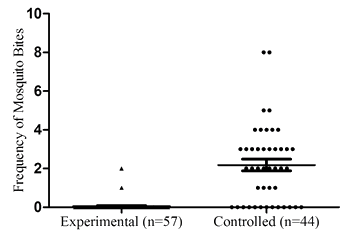
Figure 1: Frequency distribution of mosquito bites in indoor exposure test, Nepal, 2013.
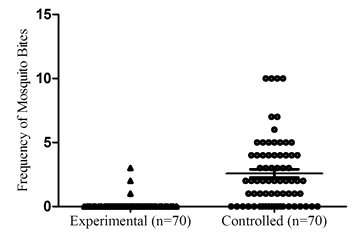
Figure 2: Frequency distribution of mosquito bites in outdoor exposure test, Nepal, 2013.
Smell satisfaction and irritation level test
In the smell satisfaction examination, 86 (67.7%) and 21 (16.5%) of the 127 participants reported the smell of the citronella oil to be 'good' and 'very good', respectively. Only 17 (13.4%) and 3 (2.4%) participants responded 'bad' and 'very bad', respectively. The IE and OE tests showed a similar tendency in the smell satisfaction level; however, 'very good' response was higher in the OE setting (27.1%) than in the IE setting (3.5%) (Fig3).
In the irritation test, 111 (87.4%) participants reported no irritation: 86.0% in the IE test and 88.6% in the OE test. The remaining 16 people (12.6%) reported a slight irritation: 14.0% in the IE test and 11.4% in the OE test. Those who felt irritation reported only a slight irritation and a mild burning sensation during the first few minutes of the application with citronella oil. No one reported a moderate or severe irritation (Fig4).
Table 1: Mosquito repellency effect of citronella oil during exposure trials, Nepal, 2013
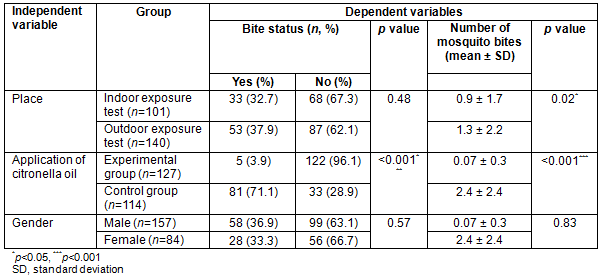
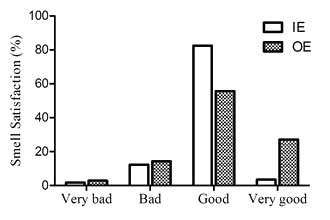
Figure 3: Smell satisfaction responses in indoor and outdoor exposure trials, Nepal, 2013.
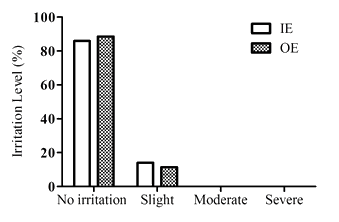
Figure 4: Irritation level responses in indoor and outdoor exposure trials, Nepal, 2013.
Discussion
The results regarding the repellency efficacy of citronella oil demonstrated that the direct topical application of citronella oil had a significant protective effect against mosquito bites compared to the non-applied group (28.9%) in both the indoor (96.5%) and outdoor (95.7%) trials for 2 hours (Table 1). As shown in Figures 1 and 2, the frequency of mosquito bites was significantly lower in the citronella oil applied group compared to the non-applied control group (p<0.001). In the survey of smell satisfaction, 84.2% of participants reported to be satisfied with the smell of the citronella oil ('good' and 'very good') at the indoor and outdoor test, showing a similar tendency. In the irritation level test, 87.4% of the participants reported no irritation, and the others reported only a slight irritation and a mild burning sensation in the first few minutes of the treatment. These results of the smell satisfaction and irritation level indicate that the topical application of citronella oil on the skin is fully acceptable to the local people, in a wide range of age groups, suggesting it could be used as a mosquito repellent in both indoor and outdoor conditions not only in rural Tikapur but also in other rural communities in Nepal or other developing countries.
The direct application of mosquito repellent to the skin is considered a simple and effective way to prevent mosquito bites during indoor and outdoor activities. Based on the evidence provided, the average protection time of citronella oil was approximately 1.5 h against Aedes mosquitoes, 3 h against Anopheles mosquitoes, and 5 h against Culex mosquitoes17. The complete repellency for the entire concentration of citronella oil lasted for at least 3 hours. Furthermore, the protection time and repellency of citronella oil can be doubled when combining it with other volatile oils, such as vanillin18,19. On the basis of these protection durations, the repellency percentage of citronella oil was calculated as 96.69% by the modified equation of Amer and Mehlhorn20 in the OE trials in this study. The results regarding the frequency of the mosquito bites and the repellency percentage of citronella oil, when applied topically, could provide a sufficient protective effect against mosquito bites in both indoors and outdoors conditions.
The Nepalese government has been implementing a continuous malaria-control program, with a long-term vision of a malaria-free Nepal by 20263. In this process, synthetic toxic chemicals such as DDT (1,1,1-trichloro-2,2-di(4-chlorophenyl)ethane), malathion, and bendiocarb have generally been used on agricultural crops and even in the control of household pests including mosquitoes, mainly through indoor residual spraying21. Despite its toxic effects on humans and the environment, due to its relatively low cost and high insecticidal effects on most species of Anopheles mosquitoes2, DDT is still considered valuable for malaria control, particularly in developing countries such as Nepal. DEET (N,N-diethyl-3-methyl benzamide)-based commercial products are currently being used around the world for their significant insecticidal effects22. However, over the past decade, the safety of DEET has become controversial and has not been clearly verified, although it is thought to be safe when used as recommended. Based on the evidence provided by the DEET Registry, considerable cases showed a strong correlation between the onset of clinical manifestations such as seizures, neurological symptoms, and dermatological cases after DEET exposure. Seizures, especially in children of 19 years and younger, have been a particularly concerning issue23. Currently, topical mosquito repellents including N,N-diethyl-benzamide (eg Advanced Odomos cream) as a main component is commercially available in Nepal and is imported from abroad, for example from India. However, very few people use them despite their relatively low cost and convenience in Tikapur. This may be related with the awareness of people about the side effects of chemical insecticide. Citronella oil has been used as a natural insect repellent for more than 50 years and is unlikely to cause harmful effects on humans, pets, the environment, and the ecosystem, as compared to synthetic insecticides24,25. Moreover, few side effects in human application have so far been reported.
Besides the adverse effects of synthetic insecticides, the affordability and accessibility of mosquito repellents should be an important consideration in the prevention of mosquito-borne diseases in economically-deprived people and communities. In 2008, Nepal was ranked 144th out of 177 nations on the United Nations' Human Development Index, and the country's gross domestic product per capita was $1100. The majority of Nepal remains underdeveloped, and over 80% of the population live in rural areas3. In particular, the far-western region of Nepal ranked fourth out of five development regions on the Human Development Index, with 46% of the population living below the poverty line26. The economic status of households and communities is closely interrelated with individual and public health. Nepal has relied on foreign aid to cover the cost of insecticides, and has imported most products from other countries to control mosquito-borne diseases because of lack of domestic production. Thus, the country needs to look for affordable and domestically-produced alternatives to reduce the cost of insecticides21,27.
Citronella plants are widely cultivated in the Terai zone throughout the country. This region comprises plains and has a tropical/sub-tropical climate. The production and distribution of medicinal and aromatic plants including citronella oil has been politically fostered under the government control for the national economy, especially since Herbs Production & Processing Co. Ltd. was established by His Majesty's Government of Nepal in 1981. This public enterprise has a central office and factory in Kathmandu, and many branches and factories in different regions of Nepal including Tikapur. The far-western region is also rich in biodiversity, including hundreds of species of medicinal herbs (jadibuti), with a production of more than 1.6 million kg annually26. For this reason, citronella oil could have a high cost-effectiveness not only for Tikapur people but also to other rural communities in Nepal. The utilization of a locally-produced, citronella-based mosquito repellent in Tikapur is expected to lower the purchasing costs of mosquitocides, to boost the economic activity of the local communities, as well as to stimulate local efforts to enhance the public health system and environmental protection. An insecticide does not need to cause high mortality on the target organisms in order to be acceptable; it is more important that it be eco-friendly in nature28. In this context, the application of citronella oil in lieu of chemical mosquitocides may represent an eco-friendly alternative as a natural mosquito repellent.
Additionally, this study was designed to confirm the effect of citronella oil as a mosquito repellent, particularly in real-life conditions that the Tikapur residents faced in their daily lives. So, the exposure conditions for the mosquito bites were adjusted in order to reproduce the actual living environment conditions of the local residents, considering their indoor and outdoor activities as well as the time at which mosquitoes are particularly active. The number and species of mosquitoes or the age and sex of the participants were not restricted. Both IE and OE tests showed a significant effect with similar tendency. This suggests that citronella oil can be utilized as a topical mosquito repellent for indoor and outdoor activities in daily life. However, it needs further study to verify the effect of citronella oil on the protection time according to the dilution ratio of citronella oil.
The topical application of citronella oil to human skin can be used as a potential alternative for both indoor and outdoor activities on the basis of its high repellency effect against mosquito bites and on the participants' high satisfaction with its smell and degree of irritation. Moreover, the affordability and accessibility of citronella oil make it a particularly viable option, as it is locally produced in the Tikapur Municipality. The use of citronella oil could lower the cost of mosquitocides, considering that the Nepalese government currently imports insecticides from foreign countries. Therefore, citronella oil preparations have high applicability for the community's health and welfare by helping to prevent mosquito-borne diseases in rural communities as well as Tikapur, Nepal.
Acknowledgement
This work was supported by a National Research of Korea Grant from the Korean Government (NRF-2013S1A5B8A01055336).
References
1. Tolle MA. Mosquito-borne diseases. Current Problems in Pediatric and Adolescent Health Care 2009; 39(4): 97-140.
2. United Nations Field Coordination Office. An overview of far western region of Nepal. (Online) 2011. Available: http://un.org.np/sites/default/files/Nepal_Far_Western_Region_Overview_Paper.pdf (Accessed 11 February 2015).
3. Ministry of Health and Population. Nepal malaria strategic plan 2011-2016 (Revised Version). (Online) 2011. Available: http://apmen.org/storage/country-partner/Nepal%20Strategic%20Plan%202011-1016.pdf (Accessed 21 January 2015).
4. Manandhar S, Bhusa C, Ghimire U, Singh SP, Karmacharya DB, Dixit SM. A study on relapse/re-infection rate of Plasmodium vivax malaria and identification of the predominant genotypes of P. vivix in two endemic districts of Nepal. Malaria Journal 2013; 12: 324-330.
5. Bista MB, Shrestha JM. Epidemiological situation of Japanese encephalitis in Nepal, Journal of Nepal Medical Association 2005; 44(158): 51-56.
6. Griffiths MJ, Lemon JV, Rayamajhi A, Poudel P, Shrestha P, et al. The functional, social and economic impact of acute encephalitis syndrome in Nepal - a longitudinal follow-up study. PLoS Neglected Tropical Diseases 2013; 7(9): e2383.
7. Fradin MS. Mosquitoes and mosquito repellents: a clinician's guide. Annals of Internal Medicine 1998; 128(11): 931-940.
8. Pun R, Pant KP, Bhatta DR, Pandey BD. Acute dengue infection in the western terai region of Nepal. Journal of Nepal Medical Association 2011; 51(181): 11-14.
9. Poudel A, Shah Y, Khatri B, Joshi DR, Bhatt DR, Pandey BD. The burden of dengue infection in some vulnerable regions of Nepal. Nepal Medical College Journal 2012; 14(2): 114-117.
10. World Health Organization. About vector-borne diseases. (Online) 2014. Available: http://www.who.int/campaigns/world-health-day/2014/vector-borne-diseases/en/ (Accessed 12 February 2014).
11. Lindgren E, Andersson Y, Suk JE, Sudre B. Monitoring EU emerging infectious disease risk due to climate change. Science 2012; 336(6080): 418-419.
12. Hsu WS, Yen JH, Wang YS. Formulas of components of citronella oil against mosquitoes (Aedes aegypti). Journal of Environmental Science and Health Part B 2013; 48(11): 1014-1019.
13. Fradin MS, Day JF. Comparative efficacy of insect repellents against mosquito bites. New England Journal of Medicine 2002; 347(1): 13-82.
14. Kamsuk K1, Choochote W, Chaithong U, Jitpakdi A, Tippawangkosol P, Riyong D, et al. Effectiveness of Zanthoxylum piperitum-derived essential oil as an alternative repellent under laboratory and field applications. Parasitology Research 2007; 100(2): 339-345.
15. Solomon B, Sahle FF, Gebre-Mariam T, Asres K, Neubert RH. Microencapsulation of citronella oil for mosquito-repellent application: formulation and in vitro permeation studies. European Journal of Pharmacy and Biopharmcy 2012; 80(1): 61-66.
16. Nuchuchua O, Sakulku U, Uawongyart N, Puttipipatkhachorn S, Soottitantawat A, Ruktanonchai U. In vitro characterization and mosquito (Aedes aegypti) repellent activity of essential-oils-loaded nanoemulsions, AAPS Pharmaceutical Science and Technology 2009; 10(4): 1234-1242.
17. Kongkaew C, Sakunrag I, Chaiyakunapruk N, Tawatsin A. Effectiveness of citronella preparations in preventing mosquito bites: systematic review of controlled laboratory experimental studies. Tropical Medicine and International Health 2011; 16(7): 802-810.
18. Suwonkerd W, Tantrarongroj K. Efficacy of essential oil against mosquito biting. Communicable Diseases Journal 1994; 20: 4-11.
19. Tawatsin A, Wratten S, Scott R, Thavara U, Techadamrongsin Y. Repellency of volatile oils from plants against three mosquito vectors. Journal of Vector Ecology 2001; 26(1): 76-82.
20. Amer A, Mehlhorn H. Repellency effect of forty-one essential oils against Aedes, Anopheles, and Culex mosquitoes. Parasitology Research 2006; 99(4): 478-490.
21. Walker K. Cost-comparison of DDT and alternative insecticides for malaria control. Medical and Veterinary Entomology 2000; 14(4): 345-354.
22. Brown M, Hebert AA. Insect repellents: an overview. Journal of American Academy of Dermatology 1997; 36(2 Pt 1): 243-249.
23. Osimitz TG, Murphy JV, Fell LA, Page B. Adverse events associated with the use of insect repellents containing N,N-dimethyl-M-toluamide (DEET). Regulatory Toxicology and Pharmacology 2010; 56(1): 93-99.
24. N'Guessan R, Boko P, Odjo A, Chabi J, Akogbeto M, Rowland M. Control of pyrethroid and DDT-resistant Anopheles gambiae by application of indoor residual spraying or mosquito nets treated with a long-lasting organophosphate insecticide, chlorpyrifos-methyl. Malaria Journal; 2010: doi: 10.1186/1475-2875-9-44.
25. Environmental Protection Agency. Oil of citronella. (Online) 1997. Available: http://www3.epa.gov/pesticides/chem_search/reg_actions/reregistration/fs_PC-021901_1-Feb-97.pdf (Accessed 4 November 2015).
26. UN Field and Coordination Office. An overview of the Far Western region of Nepal. (Online) 2011. Available: http://un.org.np/sites/default/files/Nepal_Far_Western_Region_Overview_Paper.pdf (Accessed 11 February 2015).
27. Phillips MA, Mills AJ. The operational costs of spraying residual insecticides: a case-study from Nepal. Journal of Tropical Medical Hygiene 1991; 94(2): 130-139.
28. Ghosh A, Chowdhury N, Chandra G. Plant extracts as potential mosquito larvicides. Indian Journal of Medical Research 2012; 135(5): 581-598.

